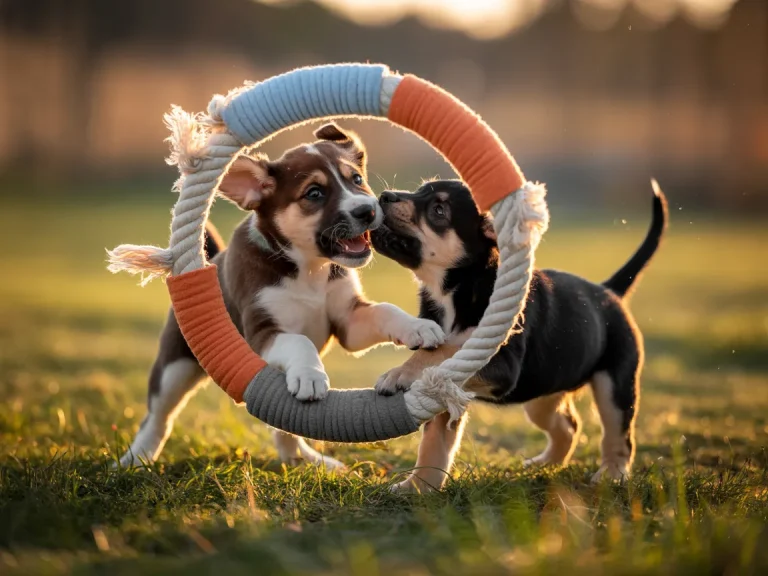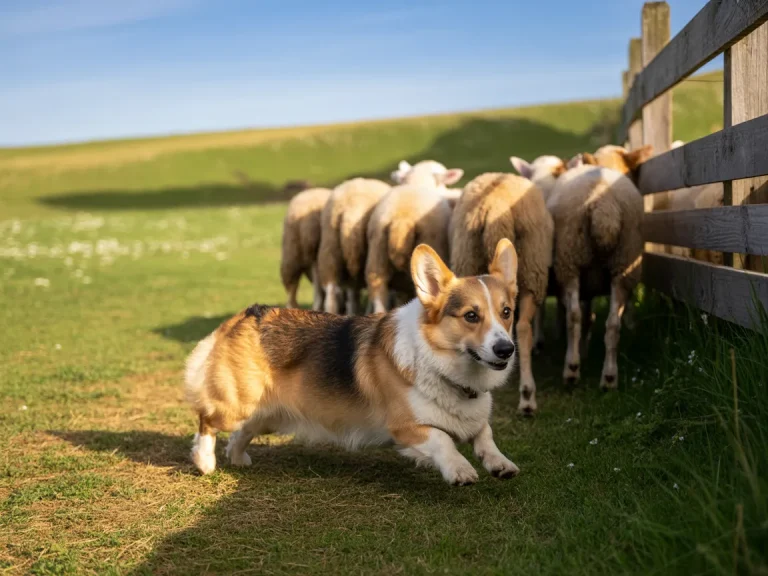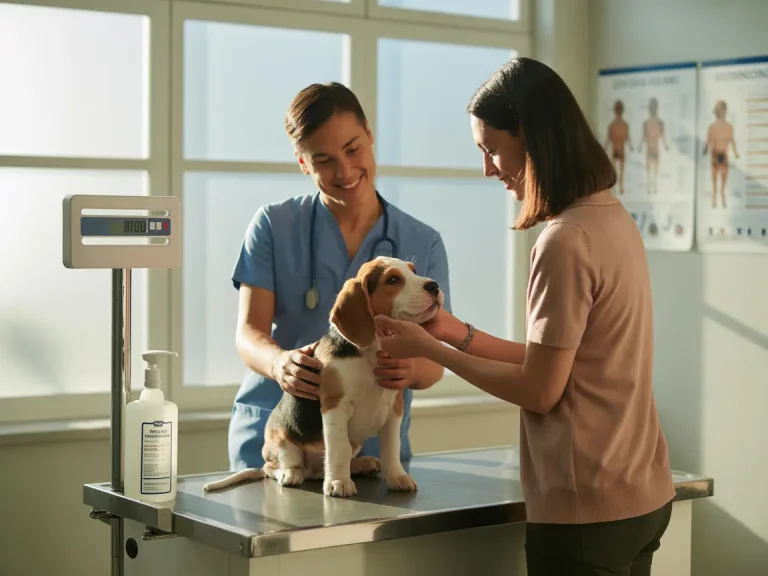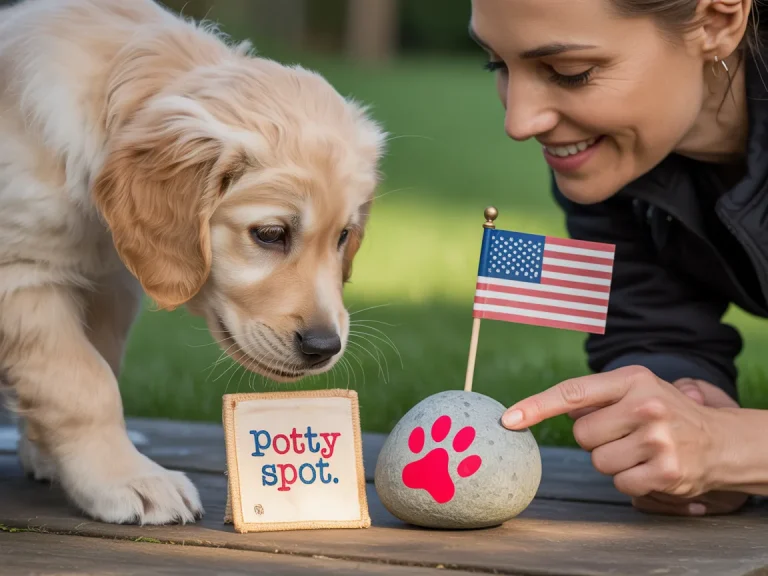A crate can be a sanctuary—a cozy den where your puppy feels safe, learns boundaries, and gets the restorative sleep they need to grow. Whether you’re raising a golden retriever puppy, a tiny maltipoo puppy, a lively corgi puppy, or a curious beagle puppy, setting up crate comfort early pays dividends in calm behavior, easier housetraining, and better sleep. This article lays out seven practical, science-aligned strategies to help your puppy associate their crate with rest, security, and positive learning without stress.
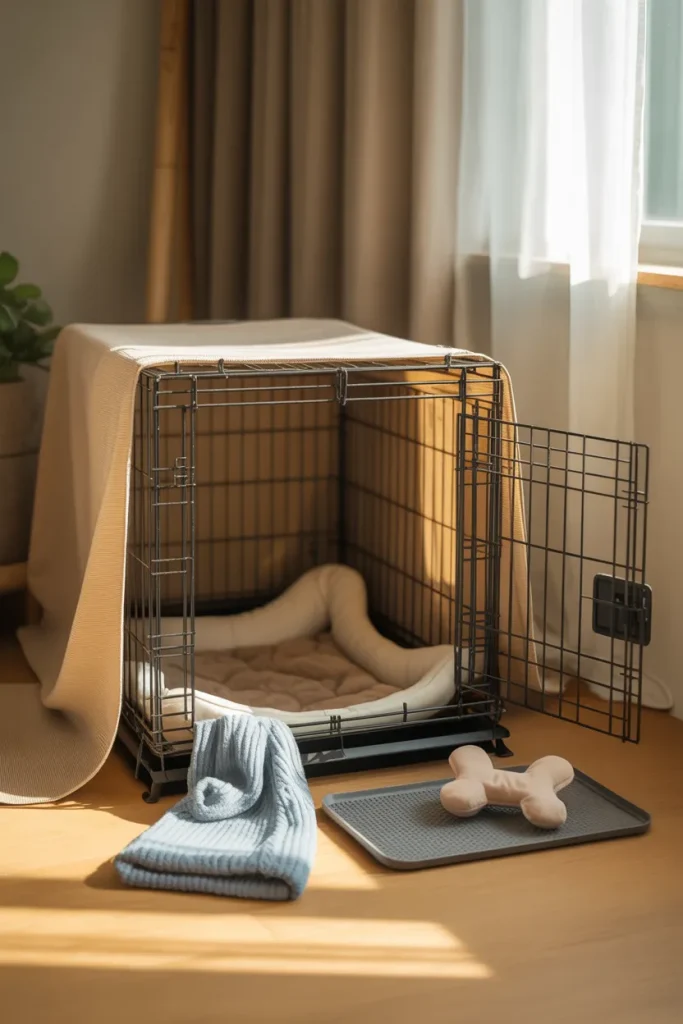
1. Choose and Customize the Right Crate
Not all crates are built the same, and your best pick depends on breed, size, and how fast your pup will grow. A pint-sized pomeranian or other small, cute puppy may be perfectly happy in a soft-sided crate for travel and naps, while a sturdier golden retriever puppy usually does best in a well-ventilated wire or plastic crate with solid latches. Think of it like picking an apartment: studio for the minimalist, brick house for the linebacker. If you want a friendly, step-by-step overview, check out the AKC’s guide to crate training.
Fit matters most. The crate should feel like a well-tailored suit—roomy enough for standing, turning, and stretching out, but not so roomy that your pup can turn one end into a bathroom. If you’ve got a grow-fast breed, pop in a divider and expand their “studio” as they sprout.
Comfort is your closer. Line the floor with a washable, non-slip pad or gentle bedding. Some pups relax faster with a light cover over the crate—instant “den mode”—as long as airflow stays easy-breezy. And for the brand-new “roommate” who misses littermates, tuck in a T-shirt you’ve worn. Your scent is a puppy’s white-noise machine.
2. Gradual, Positive Crate Introduction
We want the crate to scream “spa day,” not “time-out.” Start simple: door open, high-value treats or a sprinkle of puppy kibble just inside. Let curiosity do the heavy lifting. When your pup sniffs, steps in, or settles, mark the moment with quiet praise (or a click, if you’re using a clicker). Slide mealtimes into the crate so their brain links “this place” with “good things happen here.” This approach aligns with AVSAB’s position on humane, reward-based training.
Build it up over a few easy days. In the first day or two, you’re just tossing treats near and inside the doorway with the door open. Mid-week, close the door while they’re eating, then open once they finish—no drama, no speeches. By the end of the week, you’re adding short, calm, closed-door moments after meals while you sit nearby scrolling through photos of their adorable ears.
Got a naturally sleepy puppy? Catch those drowsy windows. Guide them into the crate when they’re already melting into a nap. They’ll learn the crate is where quiet lives, not where fun goes to die.
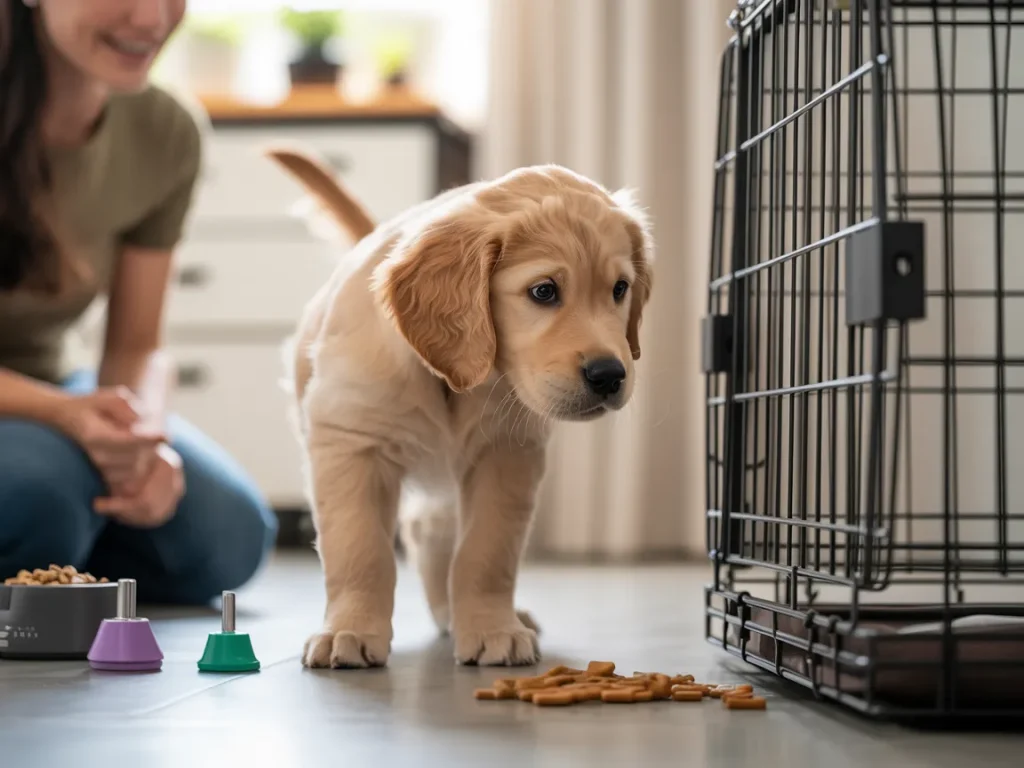
3. Use Scheduled Crate Times Around Sleep and Training
Puppies are tiny pattern machines. Set predictable crate windows: after play bursts, after meals, and after short training sessions. A well-timed nap can save you from the overtired “gremlin hour”—you know, when your sweet corgi turns into a sock-stealing land shark.
After a quick training session (think “sit,” “down,” “wait”), reward the calm brain with a short crate rest. Meals can flow into naps too: feed, let them settle for a few minutes, then guide them in for a snooze. Evenings get their own ritual—dim the lights, keep voices low, potty break, then into the crate with a soft “goodnight” cue. Do it the same way every night, and even the zippiest beagle will start to exhale on schedule.
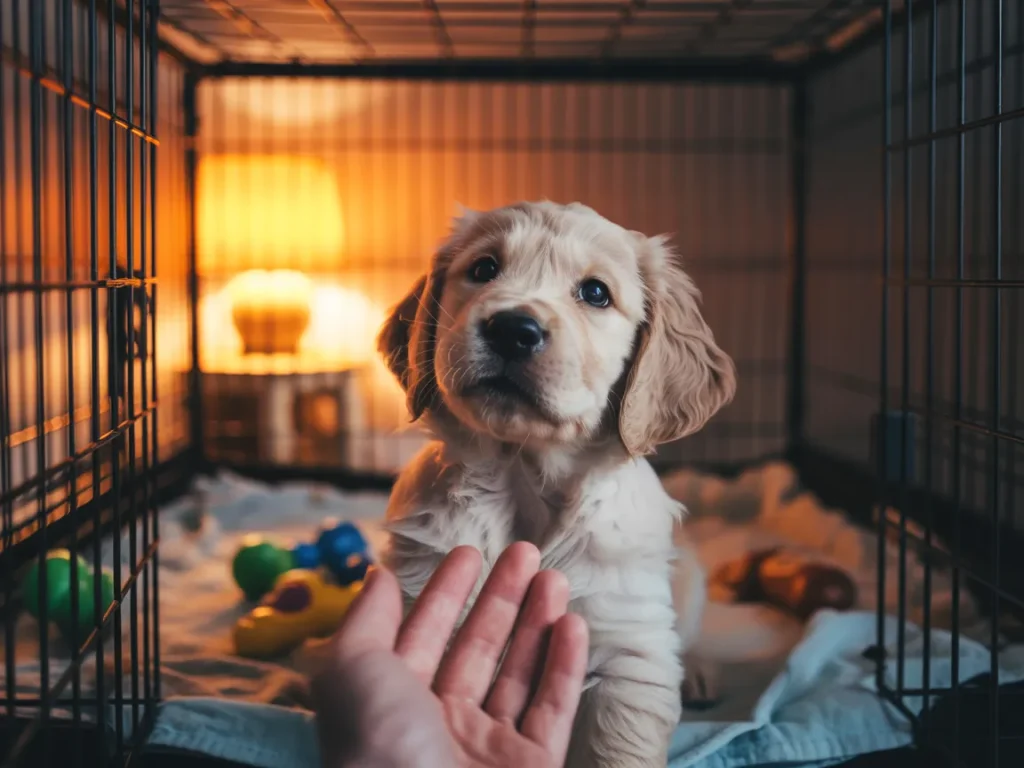
4. Reinforce Quiet Behavior with Calm Rewards
Silence is golden in crate training. If your puppy whines, resist the urge to rush over; wait for that tiny pause—the first two seconds of quiet—then calmly open the door, offer a soft pet or a pea-sized treat, and close it again if it’s still downtime. You’re teaching, “Quiet makes the good stuff happen,” not “Noise opens doors.”
Add a simple cue like “rest” or “settle,” and pair it with your slow breathing and a mellow voice. Beagles and other chatty souls may need micro-goals: celebrate two seconds of hush, then five, then ten. And here’s the biggie—don’t yank your puppy out for attention right after a noisy chorus. Wait for stillness, then greet like a gentle sunrise, not a confetti cannon.
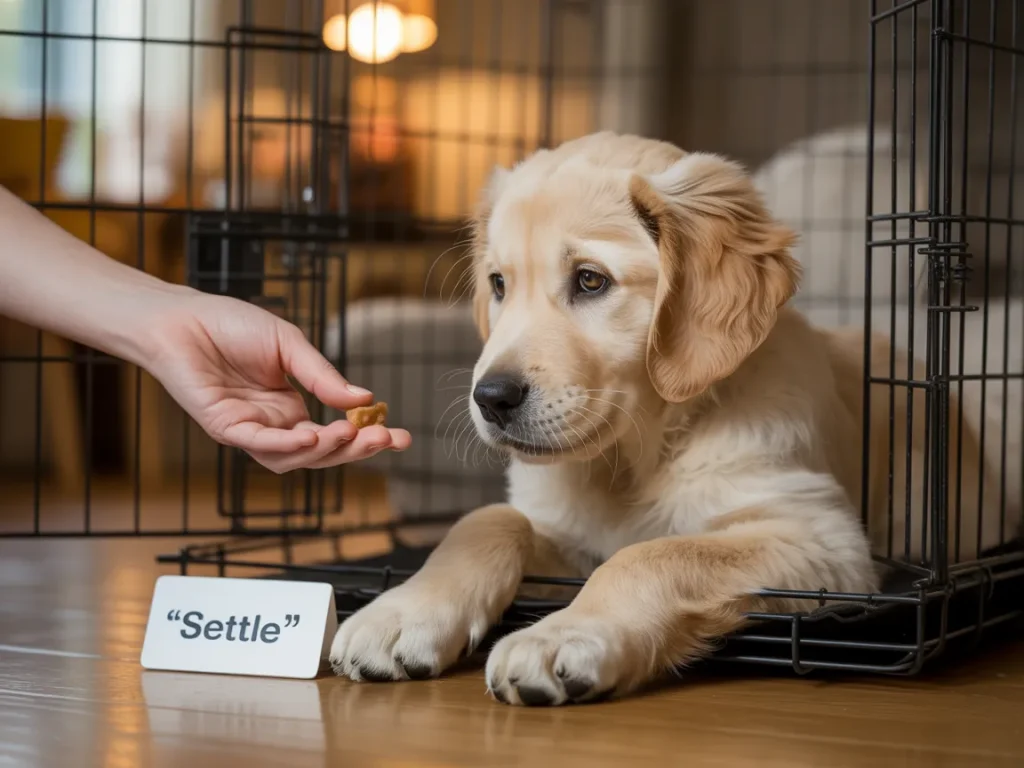
5. Integrate Gentle Sleep Aids (Behavioral, Not Pharmaceutical)
Think of the crate as a little bedroom you set to “sleep mode.” A low, steady sound—like a fan or soft white noise—can blur sudden bangs and clatters into a cozy, den-like hush. It’s the puppy version of pulling a blanket over your ears.
Lights matter, too. Dimming the room in the evening is a polite nudge to the body clock: “Hey, it’s bedtime.” That slow fade helps a puppy girl or puppy boy sync with your household’s rhythm instead of revving up at 9 p.m. like it’s a rock concert.
Offer comforting textures—a plush, chew-safe buddy or a soft pad—so the crate feels inviting rather than empty. Teething pups explore with their mouths, so choose items sized and built for their stage. If any aid seems to worry your puppy, out it goes. These tools are seasoning, not the whole recipe; the goal is calm association, not reliance.
6. Crate-Based Mini Training Sessions
Use the crate as your training “home base.” Teach three simple skills: go in on cue, chill inside, and step out like a gentleman. That little routine builds trust and self-control—whether you’ve got a spirited golden retriever or a pocket-sized maltipoo who thinks they’re ten feet tall.
Start with the “crate” cue: toss a treat inside, say “crate,” and pay when they trot in. Close the door for a beat, then open before they worry. Build duration like stacking blocks—ten seconds, thirty, a minute—always returning while your puppy is still comfortable. For exits, wait for quiet and four paws politely anchored; if they ping-pong at the door, you’re not late—you’re just practicing. Calm in, calm out. That’s the whole song.
7. Nighttime Strategy and Overnight Comfort
Night stretches can feel like the big boss level of crate training. A little crying at first is normal—it’s your pup saying, “New place, who dis?” Keep nights simple and soothing the first week: quiet room, comfy bedding, and a plan you can repeat with your eyes half-closed. If nights feel wobbly, PDSA’s crate training advice has vet-written tips on location, covers, and routine.
Wondering where to put the crate? Start it near your bed so your puppy knows you’re close, then inch it away over several nights. It’s like using training wheels—you won’t need them forever, but they make the ride less wobbly.
Very young pups (under about four months) often need a midnight pee run. Set a soft alarm, carry them out calmly, praise the business, then tuck them back in without turning it into a party. Lights low, voices low, no “Who’s a good baby?!” parade. You’re telling their brain, “Nighttime is for snoozing, not social hour.”
Pre-bed play shouldn’t be a rave. Skip roughhousing for the last 30 minutes and dial the energy down—think “library,” not “rock concert.” If you track wake times, crate duration, and night wakings for a week, patterns pop out fast—maybe dinner is a bit late, or maybe your corgi needs a longer evening sniff-walk to land that sweet, heavy sleep.
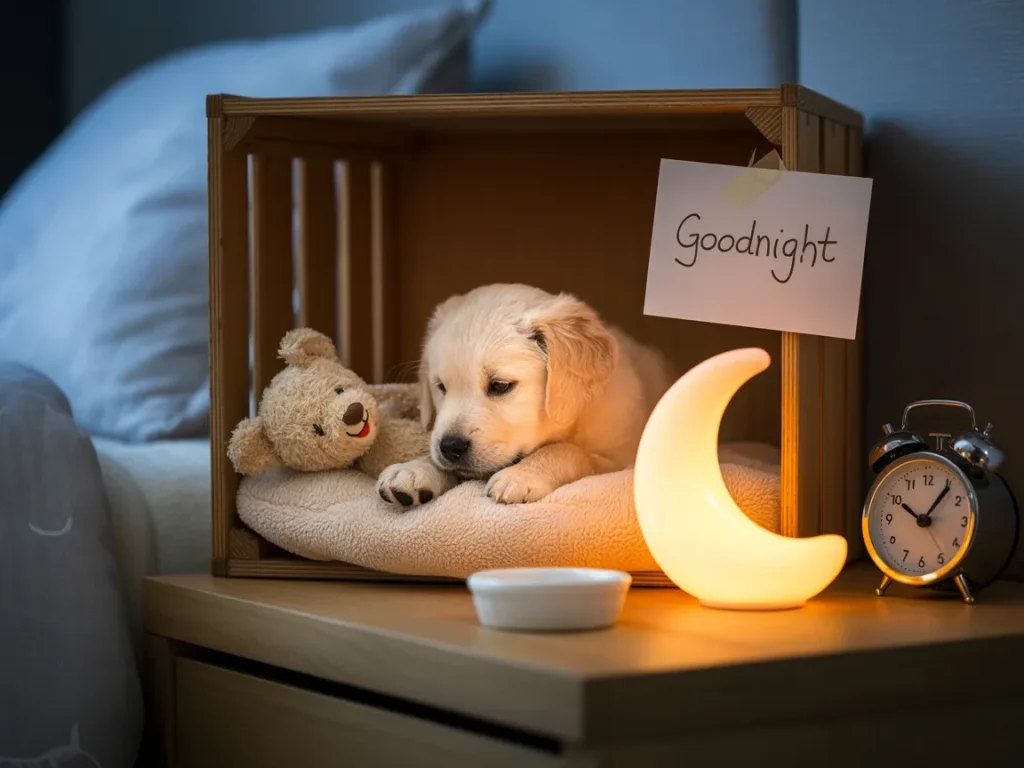
Bonus Tips for Breed and Individual Differences
Golden retriever puppy. Social butterflies with big feelings. Offer a washable plush and a soft “goodnight” cue to balance that eager heart with predictable calm. Think golden retriever brain + bedtime script = exhale.
Pomeranian puppy. Small body, big thermostat. Keep the den cozy but breezy—snug bedding without overheating. If they sprawl like a tiny starfish, you’ve nailed the temperature.
Maltipoo puppy. Sensitive souls who do best with baby steps. Add alone-time in little sips while you’re home—walk to the kitchen, come back, repeat. Confidence grows like a savings account: small deposits, daily.
Beagle puppy. Noses with legs. Let them sniff and explore before bedtime so scent-brain takes a bow. Then it’s crate, reward, lights down—showtime for rest.
Any “cute puppy,” “puppy boy,” or “puppy girl.” Labels don’t matter; stress signals do. Yawning, lip-licking, pacing? Shorten sessions and stack easy wins. The crate is a refuge, not a penalty box.
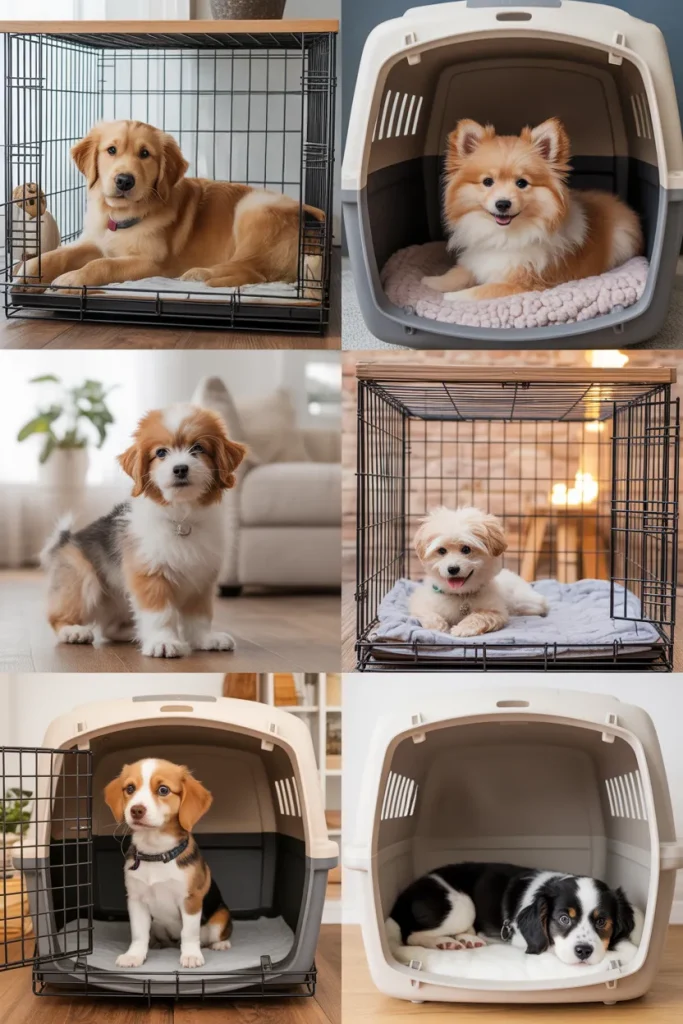
Conclusion
Crate comfort isn’t about shutting life out—it’s about giving your puppy a bedroom they trust. Choose the right space, introduce it like a VIP lounge, pair it with smart sleep routines, and reward the quiet moments. You’ll see faster housetraining, better naps, and a pup who settles like they’re slipping into a well-tailored suit. And if nights wobble at first? That’s just the learning curve doing its thing; your calm consistency is the secret sauce.
Disclaimer: This article is for informational purposes only and does not constitute professional veterinary advice. Always consult a licensed veterinarian or certified dog trainer regarding the specific needs and health of your dog.

